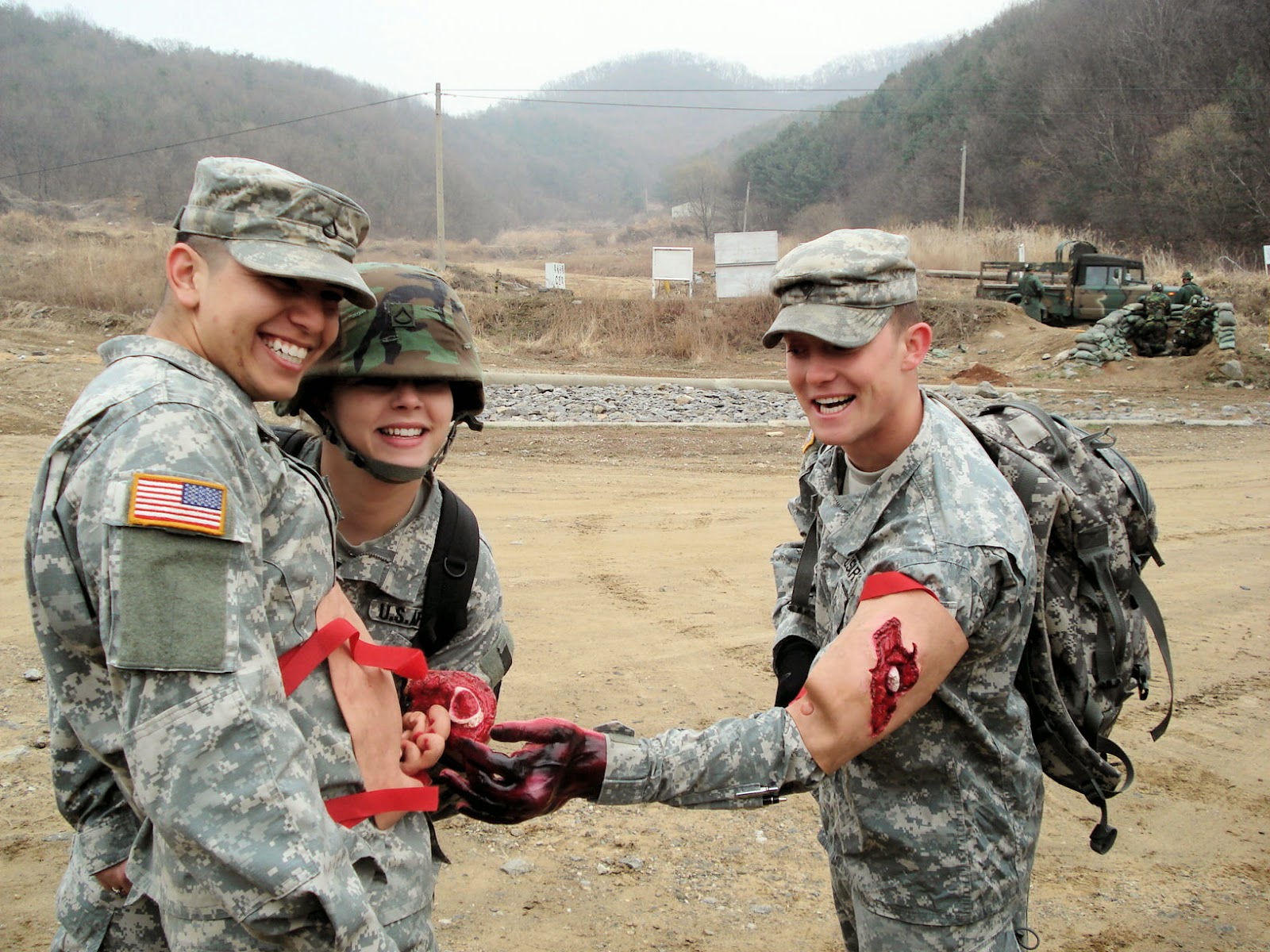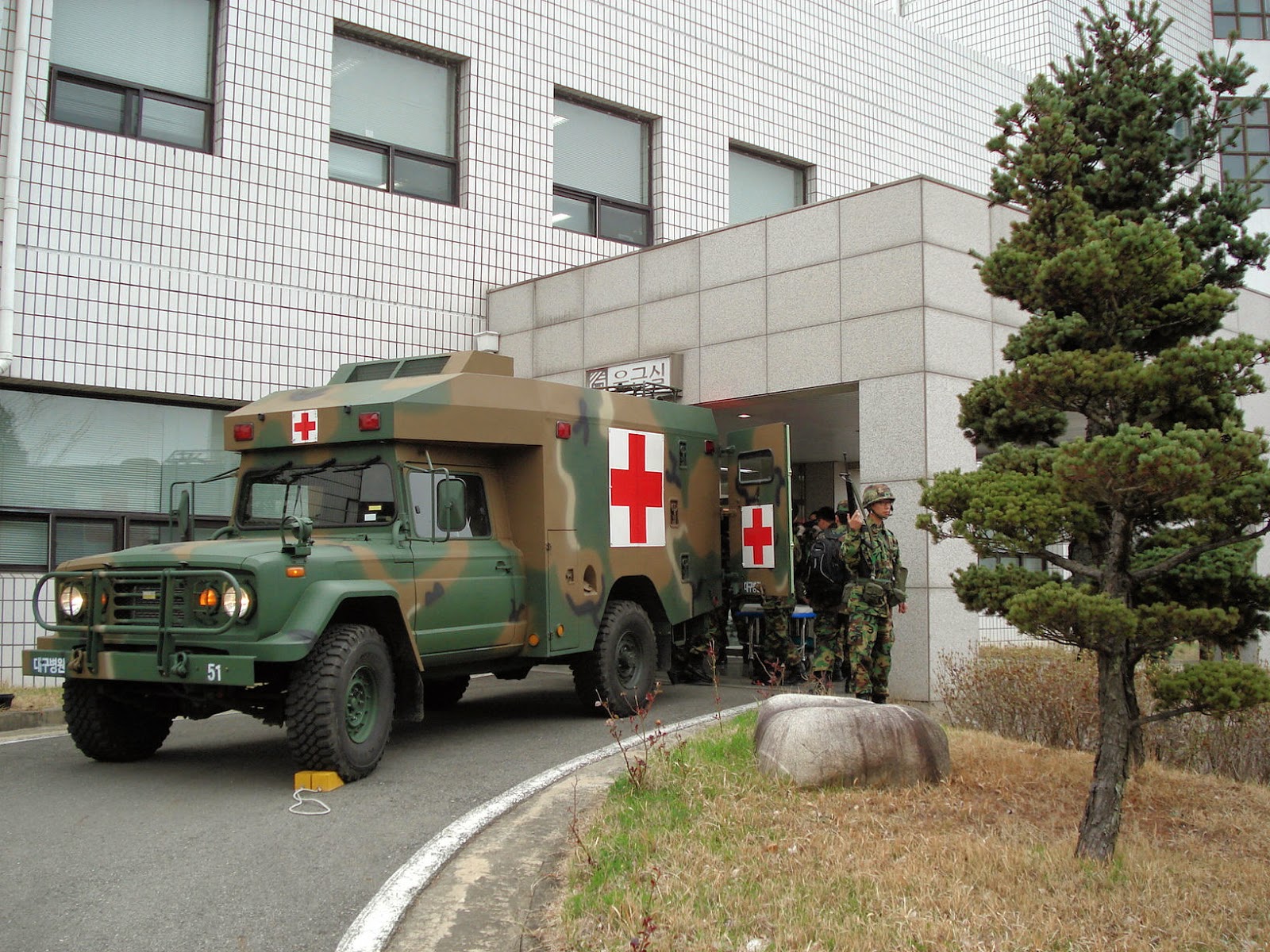Last week I was tasked to be an observer of the South Korean's ability to treat and evacuate American casualties in the event of war. The exercise was really broken up into 2 different tests. CPT Beseman, the Brigade Surgeon was going to be evacuated from Camp Red Cloud by medical airplane to Osan Air Force Base, while I was taking my medics (acting as the casualties) to Daegu, way down south, by helicopter MEDEVAC.
It's important for us as health care providers to know the capabilities of the Koreans, both in their evacuation mission and their ability to treat Americans to our standard of care. So, in addition to being a necessary exercise, it was also a fun one. Nothing like spending a couple days flying around and traveling all over South Korea.
Here we are leaving Camp Casey in the morning, moving out to the site where we would simulate being attacked by North Korean artillery (non chemical) rounds.
When we got to the site of "impact". We had the casualties dress up in moulage (fake injuries) so that the health care team would have a visual idea of what was wrong with the patient in addition to the casualties acting skills and a little card attached to them that described what injuries they had.
Below you can see Private Romero's eviscerated abdomen, Private Hawkins' (Delangre) amputated arm and Specialist Schenck's 3rd degree burned hand (his "pimp hand") and his open fractured humerus.
Below, Specialist Ussery had a sucking chest wound with pneumothorax and SPC Krzykalski also had an eviscerated abdomen.
Finally the exercise began and the casualties were loaded onto our ambulances.
Our first stop was to Camp Red Cloud in Ouijongbu. Here, the casualties were triaged and stabilized by Americans, but since these were urgent surgical patients, they needed to be shipped out to an appropriate hospital with surgical capabilities as soon as possible. This is where our test of the system really began.
Our team consisted of 4 U.S. casualties. Schenck, Ussery, Ski and my KATUSA Corporal Shin. In addition, I was there to observe with my translator, Corporal Kim. When we arrived at Yangju hospital, they were fully ready to receive us and had 4 teams of 4 soldiers ready to unload our ambulance.
Not only did they unload it in the proper order, they did it in less than 2 minutes. It was very impressive.
The soldiers were then rushed into the Yangju ER where they received more extensive treatment than they had at Camp Red Cloud.
After being treated in the ER, they were moved up to the appropriate floors, either ICU, Surgery or Orthopaedics. At this point, we were waiting for the word on whether or not the helicopter would fly or not, as it turned out, the weather was too foggy and there was some rain down South, so the helicopters were not flying that day.
We had a PAUSEX (pause exercise) and we would return the next day at the same time to resume our evacuation exercise provided that the weather was a go.
Below is Ussery in the ICU. The funny thing is that there were actually really sick ICU patients in the beds next to him.
Here I am with one of the Nursing Chiefs, Major Lee. She said that I looked like a movie star!
When they put Schenck's splint on, they crushed the pens in his arm pocket up against his arm and it was really hurting him. I loosened the splint so we could take the pens out and he was much happier.
They even served our guys lunch while they were "inpatients". It was some generic Korean food. Basically spicy chunks of stuff like tofu and other mystery vegetables. I was so hungry though that I found myself jealous that they were eating anything at all. But as I was walking back down toward the ER, one of the nurses found me and informed me that the hospital commander, the Colonel wanted me to join him in the Officer Dining Hall for lunch.
What an amazing spread they had. We sat at these round tables with a seperate round disc about 5 feet across on the middle of the table that was loaded with all kinds of food and spun around. Meanwhile, we had Korean soldiers waiting on us hand and foot, making sure our drinks were always full and picking up after us. These guys really know how to treat their officers, the food was delicious! I brought my translator with me, but they made him sit at another table, lol.
After lunch we had an AAR. Everybody in the Army knows what that is. For those of you that don't, it's an After Action Review. You basically talk about what went well, what could be improved and then address any concerns or questions that people may have regarding the exercise.
I was a little intimidated at first because I'm just a Lieutenant and I had to address the hospital Commander and all his staff, all Captains, Majors and Colonels, Nurses and Doctors and Administrative Staff. But as I got speaking and they introduced me as an American Doctor, it was all too easy. I was once again treated to being served coffee and drinks. They asked great questions and I let them know that we were very impressed with their efficiency. I learned that the hospital commander is a Plastic Surgeon and I was impressed.
Here I am with Corporal Kim, who translated for me, answering the questions of the Korean Staff.
After the AAR, we ended our exercise for the day and went back to Camp Casey. The next day we came back out to Yangju hospital and resumed the exercise from where we had left off. Everybody was pretty light hearted today, and we got a break in the weather, so we would fly by Korean helicopter down south to Daegu to evaluate the evacuation system.
The helicopters arrived and we loaded the casualties up. I traveled in Helicopter 1 with 2 ambulatory casualties and we loaded the 2nd helicopter with 6 litter patients.
The Korean MEDEVAC helicopters are exactly the same ones we use in the U.S. Army. They're UH-60 Blackhawks.
Here are some aerial photos of South Korea. It's a very mountainous country with large city buildups and then often nothing but farmland in between.
We arrived in Daegu after about a 90 minute flight and the Korean soldiers were again very quick to unload our casualties and get them loaded onto the waiting ambulances for transport up to the Daegu Hospital ER.
But maybe they were too quick.....because they dropped both Ski and Ussery as they carried the litter from the helicopter. One Korean soldier took a hard digger as he went down and cut his face up, blood was running down his cheek.
At this point I thought the exercise was over, but there was an additional plan that I didn't know about and that was to transport the soldiers from Daeugo to Heuhn Hospital on the other side of Daegu. They were transported by ground ambulance (civilian) with Military Police escort.
We arrived at the final destination, Heuhn hospital, and although they were quick to unload the casualties and get them in, we were concerned that they didn't really have a true ER and they had zero surgical capabilities. It's meant to be more of a long term care facility, something that we'll have to evaluate in determining if we'll maintain a contract with them.
Here's Colonel Joileisant, the 121 Combat Support Hospital (Our big U.S. hospital in South Korea) Commander shaking the hands of my guys and thanking them for being part of the exercise.
Finally, after two long days of travelling all around, we had to make our way home. We had tickets to ride the KTX which is a really fast Korean Bullet Train that we took from down south up to Seoul. The train went over 200 miles per hour and was as smooth as glass.
More importantly.....they served beer. So, we drank beer and made a pyramid to demonstrate how smooth the ride was.
In Seoul, we got off the KTX and got on the regular Korean subway which we took back up to Tongducheon and Camp Casey...home sweet home. We arrived only minutes before midnight and we were all exhausted.
So it was a pretty fun exercise and basically let me get out of the office for a couple days. Hope you enjoyed the pictures!
Here are some video clips of the exercise:
1. Taking off from Yangju Hospital in the helicopter
2. Aerial footage of South Korea by helicopter
3. Aerial footage of South Korea part 2
4. The Helicopters landing at Daegu Hospital
5. Moving the casualties from the Helicopter to the Ambulance
6. The helicopters taking off from Daegu








































No comments:
Post a Comment